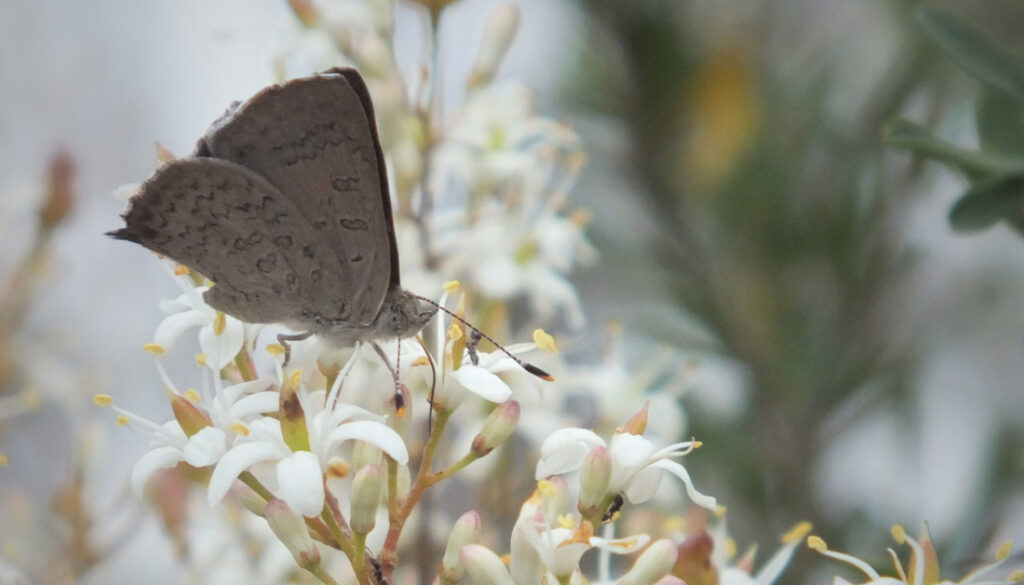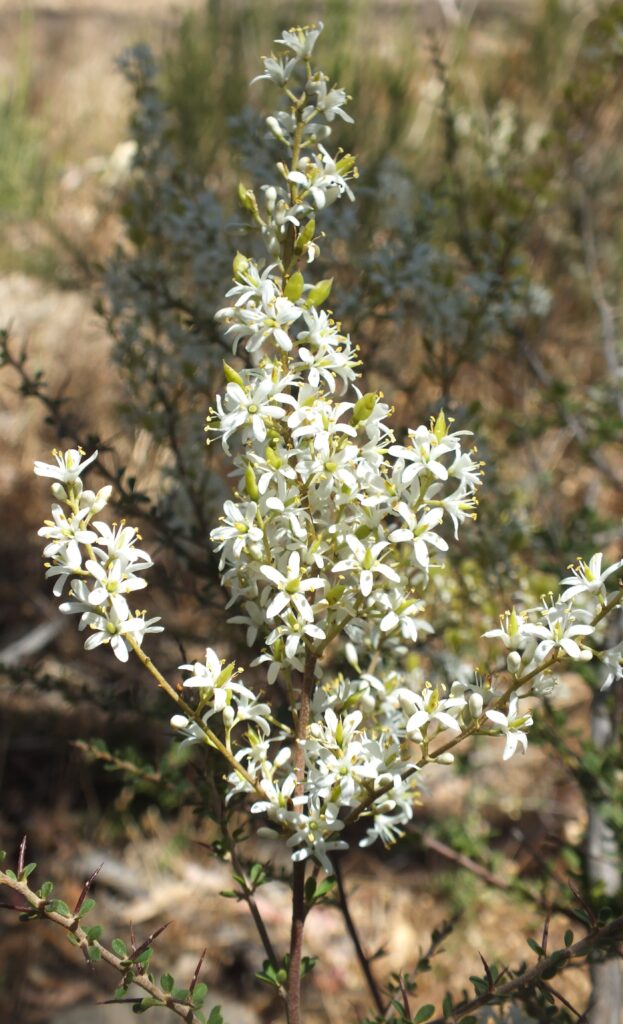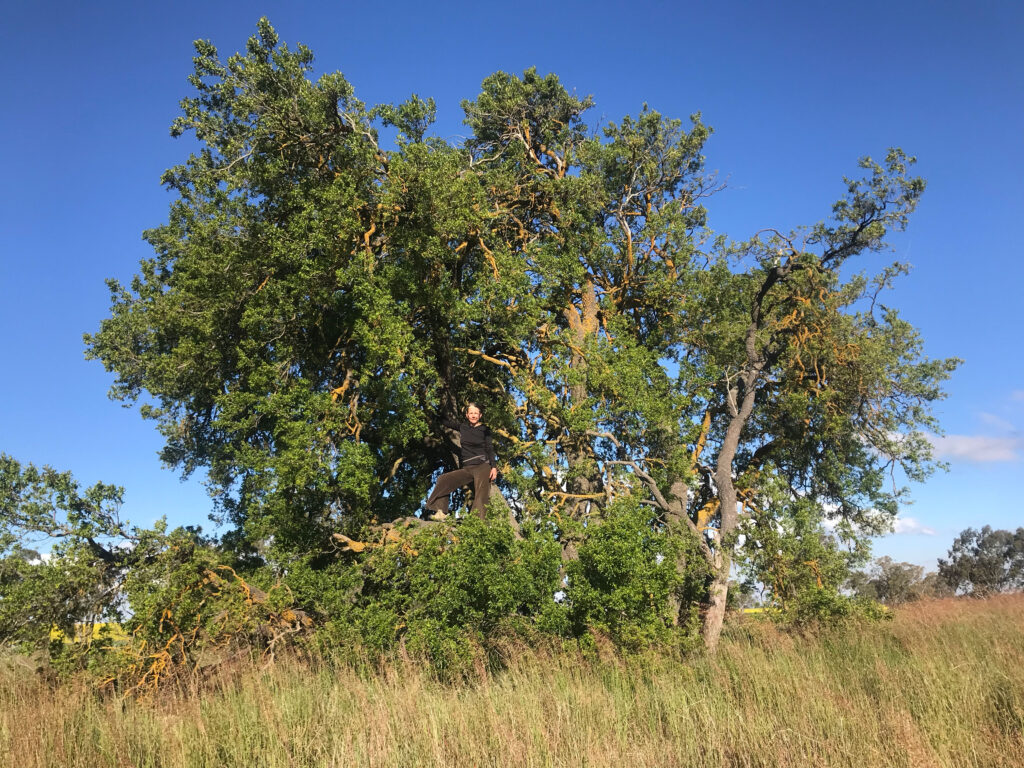ECB and Notoncus ants
All ECB are attended by one of two species of the endemic (except new guinea) ant genus Notoncus (these two species look very similar). In the Wimmera the species is Notoncus ectatommoides (which are more abundant in more grassy areas) whereas in in Melbourne/North Central regions it is Notoncus capitatus.
Ants are usually predators of Butterfly larvae however the Blue butterfly family (Lycaenidae) have evolved a range of mechanisms to overcome predation, by either deterring or attracting ants by secretion of compounds that will attract them to defend larvae instead (Australian Museum Website 2021).
79% of Blues have a relationship with ants
- 39% are obligatory (females wont lay eggs unless ants are present)
- 40% are facultative (have an ant association at some point in their life)
- 3% are carnivorous on ants
Notoncus ant nests are at the base of Sweet Bursaria and are thought to only contain worker ants. It has been suggested that this may be to protect the queen and brood from predation from Butterfly larvae. Major central ant colonies will be nearby and contain the queen and brood ants (Vaughan, 1988). For example, in Eltham the central colony was under a Grey Everlasting. This demonstrates the need to protect vegetation and the surrounding habitat in the vicinity of ECB colonies.
Notoncus ants are evidently nocturnal or crepuscular above ground foragers though this may vary seasonally, and depend on predator’s present (Brown, 1955). Ants attending ECB larvae are most active at night, either tending the larvae or roaming over the leaves and stems of Sweet Bursaria (Vaughan, 1988). During the day ants retreat to the nest, though the odd individual may be observed at the opening of the nest or moving through litter nearby (Vaughan, 1988). Ants will come to the surface in response to disturbance of the nes,t but soon retreat underground. Both Notoncus species are selective collectors of native elaiosome-bearing seeds (Berg, 1975). Elaiosomes are ant attracting tissues which occur in many Australian plant species including Acacias (Berg, 1975). Little is known on the ecology of Notoncus ants or their environmental needs. In order to protect ECB we need to protect the habitat requirements of Notoncus ants.
Notoncus ants interact with other ants that inhabitat their nearby area. ‘Both Notoncus species tend other invertebrates including Scale insects and aphids. These can be found in large numbers on the aerial stems and foliage of Sweet Bursaria and these are tended by a variety of ants. These are not only competition for the food plants but also some ant species may exert dominance over Notoncus i.e. Iridomyrmex sp which may dominate Notoncus (Vaughan, 1988). Often Mealy Bugs (Dysmicoccus) have been found in Notoncus ant nests which are also tended by Notoncus and/or Iridomyrmex sp , Vaughan did not find ECB in nests where they dominated despite the face ECB were nearby. Another ant which tends aphids, Crematogaster sp damages Sweet Bursaria leaves. (Vaughan, 1988).’
Some Blue larvae are preyed on by ants (smaller category)
- Meat ants (Iridomyrmex) preys on Azure sp larvae.(Ogyris)
- Bull ant sp prey on Imperial hair streaks (Jalmenus evagoras)
- Interestingly both of these ant sp attend other blues larvae!
Both Notoncus sp have been observed tending other species including Wattle Tick Scale and lerps (coccids or scale insects) (Alan Anderson 1991). Mealy bugs (Pseudococcids) are also in Notoncus nests (Vaughan 1988).
Ants in Australia
Australia has one of the most diverse ant faunas in the world with over 1400 species described (around 15% of the world total) ( e.g. http://antmaps.org/), however the truly re-markable extent of its diversity is not well appreciated because the vast majority of ant species in arid Australia are undescribed (Anderson 2016). For example, 138 species have been recorded in <1ha in semi-arid north-western Victoria (Andersen& Yen 1985). Anderson (2016) estimates that the total size of the ant fauna of arid Australia is as much as 7500 species, which would make it rival, if not surpass, that of the Amazon basin (Anderson 2016).
Relatively little is known about their ecology and distribution. Ants play a vital Role in Ecosystems:
- Food for other animals
- Predators and competitors of other arthropods
- Nutrient cycling
- Soil aeration
- Seed dispersal
- Plant growth and reproduction
- Ants are very important for dispersing many plant species, such as wattles, peas and chenopod
- Ants influence the vegetation structure of vegetation communities
Sole Larval Food Plant, Sweet Bursaria (Bursaria Spinosa)
- ECB larvae only eat Sweet Bursaria leaves
- ECB adults preferentially drink Sweet Bursaria nectar and emerge when it flowers
- Bursaria plant condition varies with seasons and weather, which influences ECB growth
Sweet Bursaria is widely distributed but tends to be scattered through available habitat. It is a common species in dry open woodland but rarely in dense patches. Even when you find patches of Sweet Bursaria, much of it does not harbour ECB (EPBC Advice, 2016). ECB are generally only found in around 3-26% of available habitat (Braby et al, 1999) probably reflecting the low incidence of suitable combinations of larval food plant and attendant ants (Braby, 2000).
Bursaria health impacts on ECB growth and reproductive success. Some years many plants have galls, sooty mould etc.



In order to manage ECB, it is essential that their broader quality habitat patches are managed as a whole, rather than just the areas where they are found. It is likely that within sites there is local movement and dispersal of the colonies among the larval food plants (Braby et al., 1999). Research conducted in 1987-1988 and 1994-1995 indicated that a substantial proportion of food plants used for oviposition may not be utilised in subsequent years, so that larval distribution within a site may vary between years (Braby et al., 1999).
‘Alan Yen reported that colonies move to track suitable environmental conditions. Therefore, not all available habitat at sites is suitable habitat. As vegetation ages, the habitat may become unsuitable and the population either moves on or becomes locally extinct (From EPBC Advice 2016).
